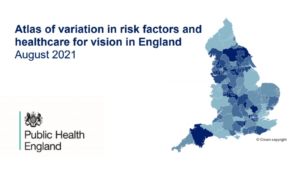Public Health England (PHE) have published the first ever Vision Atlas, looking at the geographical variation in risk factors and healthcare for eye health across England.
The new vision atlas represents the first PHE output solely focused on eye health.
The atlas brings together 32 indicators across the whole vision patient pathway, from describing populations at risk of poor eye health, through screening to healthcare services, and health outcomes. The atlas provides new analyses of hospital eye services including outpatient appointments, intravitreal injections, cataract and retinal detachment surgery.
As with all Atlases of Variation as well as providing up to date analysis PHE has worked closely with expert clinicians to provide the context, reasons for variations, options for actions and resources for healthcare providers and commissioners.
This Atlas presents data and advice to support CCGs, ICS, commissioner and providers in tackling the key issues in eye care to support the National Eye Care Restoration and Transformation Programme to rapidly recover eye services and to drive forward long-term developments and solutions to improve services and cater for future demand.
This Atlas brings together key information for local areas on actions they can take to tackle the key risk factors for eye disease – preterm birth, smoking, obesity, physical activity, and diabetes.
The Atlas also presents provisional data for 2020 and 2021 that show significant reductions in outpatient attendances and procedures for eye health during the pandemic.
Link to vision atlas:
Atlas of variation in risk factors and healthcare for vision in England
Key themes
In the past decade, the introduction of new interventions for previously untreatable eye chronic conditions has transformed service provision and clinical practice, generating multiple episodes of care. These have all contributed to the rising rates of service activity and their variations for example for outpatient attendances and intravitreal injection procedures. Ophthalmology is now the largest outpatient speciality in England. The atlas shows there were 9 million outpatient attendances for vision in 2019/20.
The atlas covers the years immediately prior to the coronavirus (COVID-19) pandemic, providing a baseline and resource for monitoring the impact of the actions to be taken subsequently for the recovery and transformation of eye health services, their organisation and delivery; and the implementation of integrated care systems.
The older you are, the greater the risk of sight loss. Of the 9 million all vision outpatient attendances in England 56% were for people aged 65 years and older. Men and women in the 85 to 89 year old age group have the highest age-specific population rates for outpatient attendances. Overall, nearly 1 in 4 individual people in the 85 to 89 age group had a vision outpatient appointment in 2019/20.
Highlights from indicators
indicators with high numbers:
- In 2019/20 there were 9 million outpatient attendances for vision in England
- 4 million individual patients of all ages attended appointments during 2019/20
- In 2019/20 there were 2.2 million outpatient first attendances for vision in England
- In 2019/20 there were over 380,000 cataract surgeries in those aged 65 year and over in England
indicators with increasing rates:
- All vision outpatient attendances have seen an increase of 37.6% in attendances from 2009/10 to 2019/20
- The England rate of all intravitreal injection therapy procedures in people aged 60 years and over has more than double in the past 7 years (over 600,000 in 2019/20)
- The England rate of admission to hospital for all cataract surgery in people aged 65 years and over has seen an increase of 16% from 2014/15 to 2019/20.
- The England rate of all rhegmatogenous retinal detachment surgery in people aged 18 years and over has seen an increase of 36% from 2014/15 to 2019/20.
indicators with high CCG variation:
- Variation in rate of all intravitreal injection therapy procedures in people aged 60 years and over (2019/20) was 188.6-fold difference between CCGs. Although it should be noted differences in organisational practice are likely to be the major, systematic factor contributing to the variation.
- Variation in rate of first intravitreal injection therapy procedures in people aged 60 years and over (2019/20) was 29.5-fold difference between CCGs
- Variation in rate of registered blind or partially sighted people aged 75 years and over (2019/20) was 26.2 fold difference between UTLAs
Covid period decreases:
- In 2020 there were 6.5 million all vision outpatient attendances, a 29% decrease from 2019
- In 2020 there were 1.4 million all vision outpatient first attendances, a 38% decrease from 2019
- There were 550,000 intravitreal injections in 2020, a 9% decrease on 2019. However, in the same time period the number of first intravitreal injections decreased by 19% (a decrease of 7,200)
- Cataract surgery has decreased by over 40% in the year 2020 compared to the previous year. In the 2020 there were 227,000 admissions for cataract surgery compared to 392,000 in 2019
- Rhegmatogenous retinal detachment surgery decreased in 2020 by 11% when compared to the previous year with 1,200 fewer surgeries being carried out
Age:
- Of the 9 million vision outpatient attendances in 2019/20, 5 million of them were seen in the over 65s which is 56% of all vision outpatient attendances.
- In 2019/20, 3.4 million people attended a vision outpatient appointment. The over 65 age group made up 51% of all vision outpatients, this age group makes up 17% of the population.
